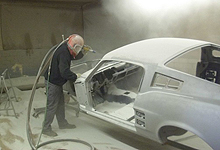Once sandblasting of the body is complete, it is very important to carefully blow out any blasting abrasive remaining in the cavities. Otherwise, when it comes time for painting, abrasive particles will turn up in the paint.
The cleaned sheet metal must also be thoroughly primed, since it is naturally very susceptible to further attacks by surface rust.
Our many years of experience in classic car restoration help us to safely avoid the potential pitfalls mentioned above. Still, we are selective in our use of this skill, targeting especially cases in which it makes good sense and is superior to other techniques such as ice blasting.
Sandblasting is especially useful for work on smaller parts such as brake and steering components, stabilizers, mountings, chassis parts, or entire rear axles. In this domain its results are unmatched and it is so much a part of our everyday work that we cannot imagine life without it. Treating such parts is quick and completely safe, and the results that can be achieved are self-evident. |
|
|







